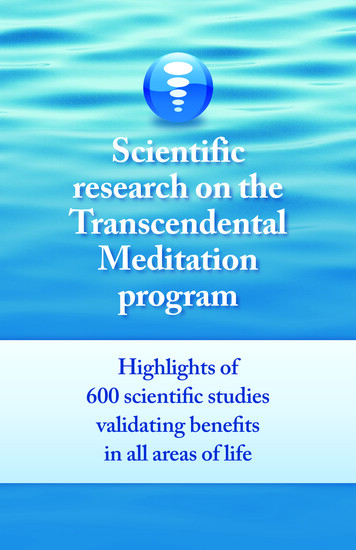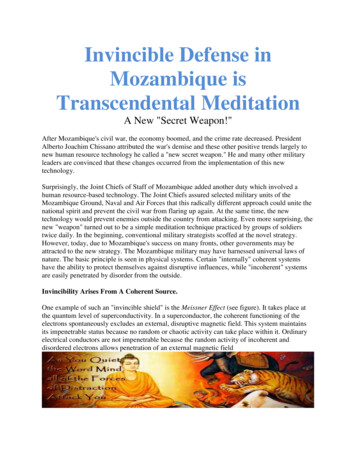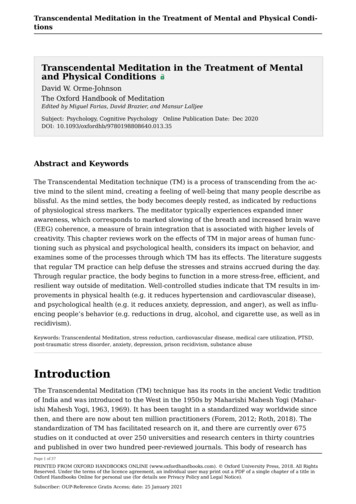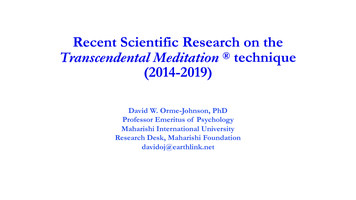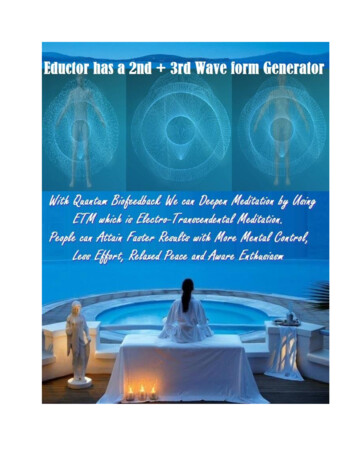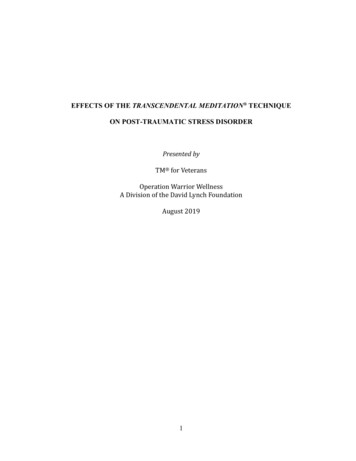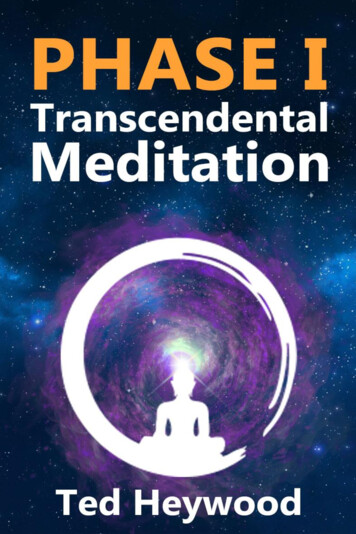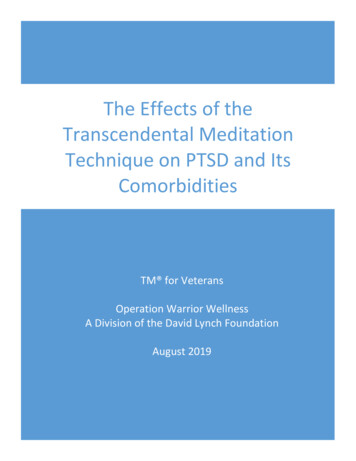
Transcription
The Effects of theTranscendental MeditationTechnique on PTSD and ItsComorbiditiesTM for VeteransOperation Warrior WellnessA Division of the David Lynch FoundationAugust 2019
Table of ContentsExecutive Summary . 2The Problem . 4Need for New Approaches . 4The Transcendental Meditation Technique . 5Research on the TM Technique and Stress Reduction. 5Research on the TM Technique and PTSD . 7Trials on TM and PTSD in Veteran Populations . 9Randomized Trials . 10Non-Randomized Studies on TM and PTSD in Veteran Populations . 14Studies on TM and PTSD in Non-Veteran Populations . 18Prison Inmates . 18College Students . 20War Refugees . 20Effectiveness of TM in Treating Comorbidities of PTSD . 21Depression . 21Substance Use Disorder . 22Anxiety . 22Sleep Disorders . 23Hypertension. 23Comparison of the TM Technique and Mindfulness Meditation . 23Comparison to First-Line Treatments and Value-Added with TM . 25Value-Added of TM . 27Acceptability of TM to Veterans . 28Feasibility of Program Implementation . 29Boulder Crest Retreat Warrior PATHH Program . 29Eisenhower Army Medical Center, Fort Gordon, Georgia . 30National Substance Use Disorder Pilot Program . 30Veteran Affairs Medical Centers . 30Norwich University. 30National Defense University . 31TM Center-Based instructions . 31Cost Effectiveness of the Transcendental Meditation Technique . 31High-Cost Groups . 32Elderly populations . 33Non-Elderly Populations . 34Conclusion . 35Appendices . 45Appendix 1: Veteran Experiences with TM . 45From Interviews Conducted by or Letters Written to the David Lynch Foundation . 45From San Diego RCT . 48From Boulder Crest Retreat Center Participant Reports . 49Veterans Lifeline Survey Responses about Benefits of TM . 49Appendix 2: The Effect of TM on DSM Criteria. 52Appendix 3: Selected Research on the Transcendental Meditation Technique . 70 2019. David Lynch Foundation, a non-profit educational organization. All rights reserved. Transcendental Meditation and TM are protectedtrademarks and are used in the U.S. under license or with permission. 2019. Maharishi Foundation USA, Inc., a non-profit educational organization. All rights reserved. Transcendental Meditation and TM areprotected trademarks and are used in the U.S. under license or with permission.2
Executive SummaryPost-Traumatic Stress Disorder (PTSD) is a serious and disabling condition that affectsapproximately 6% to 7% of adults in the U.S. over their lifespan. The incidence is at least two tothree times greater in veterans and active-duty personnel who have seen combat. PTSD is associatedwith co-morbidities such as major depression, substance abuse, suicide, and poor physical health. Itis widely recognized that current pharmacological and psycho-therapeutic approaches to treatingPTSD are not fully adequate, because of limitations in both effectiveness and acceptability. As aconsequence, there is an acknowledged need to identify new approaches to treating PTSD that areboth effective and acceptable.The Transcendental Meditation technique (TM ) is a simple, non-religious, and easy-to-learnmeditation practice that has been extensively researched and learned by millions of Americans.The more than 420 peer-reviewed studies conducted on TM over the last 50 years havedemonstrated that the TM technique is effective at treating stress-related conditions, such ashypertension, anxiety, and depression, as well as enhancing physical health, energy and cognitivefunction. This white paper summarizes the research that has been done on the TM technique andPTSD. For this analysis we located 14 studies on the effects of TM practice on PTSD symptoms:11 peer-reviewed and 3 non-peer-reviewed. Nine of these are on veterans and active military.Four with veterans are randomized controlled trials (RCT) and two with civilians are RCT.Major conclusions of this research are as follows: Research on the TM technique shows large effect sizes that appear comparable to currentfirst-line therapies for treating PTSD. This finding is consistent across study design,PTSD population, and researcher affiliations.TM works quickly. Research that measured very short-term effects of practice foundclinically significant reductions in PTSD symptoms within two to four weeks of learning.TM is acceptable to veterans. In the past decade, more than 4,000 veterans, active-dutypersonnel, and cadets have learned TM. Intent-to-treat research has shown thatcompliance with TM practice is at least equivalent to other treatment programs. BecauseTM is widely practiced for resilience-building and growth in corporate and educationalsettings, it lacks the stigma associated with psychotherapeutic treatments.The published research on the TM technique and PTSD and over a dozen federallyfunded studies on heart health and mental health have not found treatment-related adverseevents, indicating the safety of TM practice.Published data indicate generally larger effect sizes for the TM technique than for othermeditation programs on improving stress-related conditions (anxiety, depression, andhypertension). A review of published PTSD research shows that Mindfulness BasedStress Reduction has a moderate effect and TM practice has a large effect on reduction ofPTSD symptoms.TM simultaneously treats the comorbidities associated with PTSD. TM practice has alarge effect on reducing PTSD-related depression and has significant effects on reducinganxiety, substance abuse, sleep disorders, and hypertension.There are potential cost savings from introducing the TM technique as a first-line PTSDtreatment both from its ameliorating effects on PTSD and comorbid conditions. Priorresearch in the general population shows that TM practice leads to significant reductionsin health care costs.The body of research taken as whole, including published RCTs, indicates the use of the TMtechnique as a first-line treatment for PTSD and comorbid conditions.3
The ProblemPost-Traumatic Stress Disorder (PTSD) is a serious and disabling condition that affectsapproximately 6% to 7% of adults in the U.S. over their lifespan.1 The incidence is much greaterin veterans and active-duty personnel. PTSD is estimated to affect 14% deployed in our wars inAfghanistan and Iraq2 and studies place rates of PTSD as up to 30% lifetime prevalence forVietnam Veterans.3 Currently 26.7% of Iraq and/or Afghanistan veterans who seek care from theVeterans Health Administration receive a PTSD diagnosis.1PTSD takes a severe toll on the mental, physical, and financial wellbeing of veterans and theirfamilies.4,5 PTSD is associated with co-morbidities such as major depression, substance abuse,suicide, and poorer physical health. Furthermore, there is an increased cost of disability.6,7,8 Theestimated two-year cost for PTSD is up to around 10,000 per person, when considering liveslost to suicide2. This rises to around 17,000 when co-morbid depression is present. Thesefigures do not account for other costs such as associated substance abuse, homelessness, anddomestic violence, which may account for up to around 6 billion dollars in lost productivity ayear.2 Taken together, these findings highlight the need for increased and persistent attention tofinding effective treatments for PTSD.Need for New ApproachesThe two most commonly used forms of treatment for PTSD involve the use of pharmaceuticals,and/or forms of Cognitive Behavioral Therapy (CBT). Both of these have their limitations.Drugs can be targeted toward particular symptoms, such as depression, anxiety, insomnia,nightmares, etc., but it is generally recognized that there is no drug or drug cocktail that isspecific for, or can effect a cure in, post-traumatic stress.9 Sertraline, in a 2018 study, was foundto have comparable effects to Prolonged Exposure therapy,132 but it also has many side effects.135There are many forms of CBT, but two of them have become recognized as the “gold standard”treatments, and essentially are the standard of care for psychological interventions for PTSDwithin the Veterans Administration and the Department of Defense. These two are ProlongedExposure (PE) and Cognitive Processing Therapy (CPT). In a 35-year review of randomizedcontrolled trials (RCTs) from 1980 to 2015, researchers found that the two gold standardtreatments did produce clinically meaningful symptom improvement in 49%-70% ofparticipants; however, two-thirds of veterans with PTSD treated with PE or CPT retained theirdiagnosis after completing treatment.10 In addition, dropout rates among patients receiving PEtreatment shown in randomized trials and clinic-based visits can be high, ranging from 30% to44%.10,11 These relatively high dropout rates in PE may be due to the discomfort and anxietyoften reported by patients completing the therapy.10 A number of other studies that look more athow an intervention performs in a “real world” setting have shown that many veterans find the“best” treatments intolerably uncomfortable; completion rates can be extremely low, even 10%or less.12-14A further problem with the psycho-therapeutic approaches to PTSD is the issue of stigma. Whenone engages in these therapies, one is admitting to the condition, and PTSD is associated withmental illness. For some people, therapy is associated with weakness; others want to avoid itbecause of the perceptions that others have of people with PTSD as unpredictable, incompetent,or even dangerous. Seeking therapy can also have job implications. The Questionnaire for
National Security Clearance, for example, asks, “In the last seven years, have you consulted witha health care professional regarding an emotional or mental health condition, or were youhospitalized for such a condition?” Individuals do not want to engage in treatments that couldcreate doubts about their reliability or judgment. The Department of Defense is trying to recastthe seeking of treatment as a “strength,”15 but there is wide perception that a PTSD diagnosis canimpair career growth.Given the limitations of existing treatments, many health professionals and researchers recognizethe need to identify new approaches to treating PTSD: “There is a need for improvement inexisting PTSD treatments and for development and testing of novel, evidence-based treatments,both trauma-focused and non–trauma-focused.” 10 The Transcendental Meditation (TM)technique is a new approach that now has a body of research and implementation record tojustify use as a first-line treatment for PTSD.The Transcendental Meditation TechniqueThe Transcendental Meditation technique is described as a simple, natural, effortless techniquethat is practiced twice a day for 15-20 minutes. It has been learned by more than three millionAmericans of all religions and backgrounds. It has been taught in many settings, includingschools, businesses, VA Centers, universities, substance abuse centers, and prisons.35 Clinicalreports indicate that the TM technique can easily be learned by individuals of any age, level ofeducation, occupation, or cultural background.16-20 TM practitioners are instructed to sit in acomfortable position, with eyes closed. TM practice does not involve breath control proceduresor specific breathing patterns.21The practice of TM is considered safe and does not involve adopting any system of spirituality orbelief. No adverse events were reported in an efficacy review of 20 randomized controlled trialsthat included 397 experimentally treated subjects,22 and no safety concerns were raised in areport examining 813 studies of meditation practices for health, including the TM technique.23These findings supported the safety and potential efficacy of this meditation practice for treatingcertain illnesses, particularly in nonpsychotic trauma and stress-related disorders such as PTSD.Importantly, the NIH-sponsored clinical trials using TM for treating PTSD did not find anyadverse effects from TM practice.24Research on the TM Technique and Stress ReductionThe TM technique targets stress generally rather than being trauma focused. This is significantbecause it allows TM simultaneously to address PTSD and comorbid conditions that are stressrelated. It also allows TM practice to be used as a resilience-building tool to prevent stressrelated conditions, in addition to being used as a treatment for these conditions. Multiple studieson neurophysiological changes during TM practice indicate that it produces changes counter tothe stress response.The stress response involves complex neuroendocrine changes characterized by increasedsympathetic activation. TM practice has been found to reduce baseline levels of stresshormones.25-27 It facilitates a more adaptive response to stress by the unique deep metabolic restgained during the practice, in which the body’s homeostatic mechanisms normalize malfunctionsin the system. A meta-analysis of 32 studies performed during and outside the TM technique5
found consistent evidence for reductions in sympathetic nervous system (SNS) activation, asindicated by acute reductions during TM practice in respiratory rate and plasma lactate andincreased basal skin resistance compared with eyes-closed rest in control subjects. There werealso lower baseline levels of heart rate, respiratory rate, plasma lactate, and spontaneous skinresistance responses outside of meditation,28 suggesting that regular TM practice habituates thesystem to function in a calmer style outside of meditation. Related studies have indicatedreduced turnover of the stress hormones norepinephrine and epinephrine, which also reflectreduced SNS activity due to TM practice.29 These factors may contribute to reduced totalperipheral resistance and, subsequently, to reduced high blood pressure and cardiovasculardisease risk.30The hypothalamic-pituitary-adrenocortical (HPA) axis provides mechanisms by which emotionsand stress produce hormones that impact the body. For example, mental stress and elevatedbaseline levels of plasma cortisol, a major stress hormone in humans, are associated with agreater prevalence of heart disease.31 Prospective and randomized studies of the TM techniqueindicate that it has acute as well as longitudinal effects on reducing baseline cortisol and onreducing average cortisol across stress sessions.27,32Other stress-related hormones of the HPA axis, aldosterone and dehydroepiandrosterone sulfate(DHEAS), also change with TM practice. Aldosterone, a hormone that increases the absorptionof sodium and water in the kidneys, decreases with TM practice, suggesting another mechanismby which the practice may reduce blood volume and normalize blood pressure.31 DHEAS levelstend to be elevated in TM practitioners.33,34 Lower levels of DHEAS are a significant predictor ofcardiovascular disease and ischemic heart disease, controlling for other risk factors.The impact of TM practice on the sympathetic-adrenal-medulla system, crucial in an organism'sphysiological response to outside stimuli, was studied by examining plasma catecholamine levelsat two different times of day. Morning and evening levels of the stress hormones norepinephrineand morning epinephrine were significantly lower in the TM group compared with controlsubjects, suggesting a reduced hormonal response to daily stress caused by sympathetic toneregulation.26In addition to this physiological research, which suggests a physiological mechanism for theeffects of TM on PTSD, there is extensive psychological research on TM, independent of theresearch specifically on PTSD, showing that TM practice produces effects counter to the DSM-5symptoms associated with PTSD. The table below presents the four clusters of symptoms thatDSM-5 associates with PTSD136 and research on the TM technique, showing reductions in thosesymptoms.6
DSM-5 SymptomsRe-experiencing the event: Recurrentmemories of the event, traumatic nightmares,dissociative reactions, prolongedpsychological distressSample Relevant TM Research Increased autonomic stability and decreasedobsessive thoughts (120, 121) Increased emotional stability and decreasedtension (122) Decreased anxiety (133, 65)Alterations in arousal: Aggressive, reckless or Reduction in use of illegal drugs, alcohol,self-destructive behavior, sleep disturbances,and cigarettes (127)hypervigilance Improved sleep (128,129) Decreased hostility and impulsive behavior(140, 141)Avoidance: Distressing memories, thoughts, Increased ability to live more fully in theor reminders of the eventpresent and to connect past and presentmeaningfully; increased self-actualization(124) Increased field independence (142) Decreased over-sensitivity (123)Negative alterations in cognition and mood: Reduced psychological distress, anxiety,Persistent negative beliefs, distorted blame, orand depression; improved coping abilitytrauma-related emotions; feelings of(125, 126)alienation and diminished interest in life Improved ability to focus (137, 138) Reduced cognitive distortion (139) Increased self-actualization (124)Appendix 2 lists the 20 DSM-5 PTSD criteria and presents TM research relevant to each. Thebottom line is that there is extensive research, both physiological and psychological, showing theability of the TM technique to positively impact conditions associated with PTSD and suggestinga mechanism by which this might occur.Research on TM and PTSDWe located 11 peer-reviewed studies on the effects of the TM technique on PTSD symptoms: sixstudies on war veterans [Brooks & Scarano, 198549; Heffner et al., 201424; Herron and Rees,2018101; Kang et al., 2018102; Nidich et al., 201837; Rosenthal et al., 2011103], two studies on warrefugees [Rees et al., 2013104; Rees et al., 2014105], two studies on prison inmates [Nidich et al.,2016106; Nidich et al., 2017107], and one on university students [Bandy et al., 2019108]. Inaddition, we found three unpublished studies on TM for veterans with PTSD: one RCT that hasjust been submitted for publication,112 and internal reports on programs run by Boulder CrestRetreat Center38 and the Annapolis Veterans Center.111A summary of the study characteristics of these studies is found in Table 1 below. More detailedinformation on each study is found in text below the chart. In summary, all of the studies showedthat the TM technique had a large effect on reducing PTSD symptoms, and those studies that7
included assessment of depression also found a large effect on reducing this salient comorbidityof PTSD.Table 1. Study Characteristics: The Transcendental Meditation techniqueStudy IDLocationPopulation/Trauma (Total)%MalesDuration(wk)*Brooks, 1985Denver VAWar Vets/CombattraumaRCTDSM calResearchAssociates,Rockville,MDSaginaw MIVAWar ar Vets/CombattraumaWar Vets/CombattraumaWar Vets/CombattraumaWar Vets/CombattraumaWar Refugees/CombatTraumaWar Refugees/CombatTraumaMen PrisonInmates:InterpersonalviolenceRCTMM, stNonePCL-M,CAPS59(12.8)2979.39, 17RCTProlongedExposure,Health EdMatchedControlsCAPS,PCL-M47203834, 6, 8,10, 13PCL-C32.821654,19PrePostNonePCL-C33.211731.4, 4RCTTreatment 016Heffner, 2014Saginaw, MIHerron, 2017TM CentersnationallyKang, 2018(Minneapolis)MinneapolisMN VANidich, 2018San DiegoVARees, 2013Kampala,UgandaRees, 2014Kampala,UgandaNidich, 2016OregonStatePenitentiaryNidich, 2017Coffee CreekCorrectionalFacility inWilsonville,ORJohannesburg,South AfricaWomen PrisonInmates:InterpersonalviolenceRCTWait 216829.42, 4, nts in aComparableCollegeTreatment asUsualCAPS-5PCL-5BDI, BAIISI,51408512Bandy, 2019Bellehsen,submittedCT8
Tedeschi &Moore, 2019Chapin, 2016Health CenterL. Island, NYBoulder CrestRetreatCenter,VirginiaAnnapolisVet Center,MarylandQ-LESWar Vets/CombatTraumaPrePostNonePCL-5NA49War Vets/CombatTraumaPrePostNonePCL-MOQ-45NA12Trials on the TM Technique and PTSD in Veteran PopulationsFigure 1. Effect Sizes of Research on the TM Technique and PTSD with CombatVeteransAs this summary chart shows, the various research studies on the TM technique and PTSD inveteran populations consistently show that TM has a large effect1 ( .80) on reducing PTSDsymptoms. Details on the studies follow.1Effect size in statistics provides a quantitative measure of the magnitude (or effect) of atreatment. An effect size of .2 is considered small, .5 medium, and .8 or greater large.952,78NA8
Randomized TrialsNidich et al., 2018 (37)This study, funded by theDepartment of Defense andpublished in The LancetPsychiatry, is the largest RCT onTM practice and PTSD. It was anon-inferiority trial, designed toassess whether TM was noninferior to Prolonged Exposure(PE), considered the “goldstandard” therapy for treatingPTSD. Both the TM techniqueand PE were compared to anactive Health Education (HE)treatment. The study randomlyassigned 203 veterans withclinical PTSD (CAPS score 45)Figure 2. Comparison of the TM Technique, Prolonged Exposure,to either Transcendentaland Health Education on PTSD and DepressionMeditation practice (N 68), PE(N 68), or HE (N 67). Eachtreatment provided 12 sessions, 90 minutes each, over 12 weeks, in addition to daily homepractice. The table and figures below show the results for PTSD symptoms and depression. All202 eligible patients randomly assigned to treatment were included in the intent-to-treat analysesregardless of treatment dropout or missing post-test data. The study found that both the TMtechnique and PE were significantly more effective than HE. TM practice was significantly noninferior to PE for CAPS, PCL-M, and depression (PHQ-9) scores when using baseline dependentscore, number of PTSD medications, sex, and number of years since discharge from the armedforces as covariates (p 0.0002).Table 2: Between-group changes in primary and secondary outcomesTM vsHEPE vsHETM vs ession ctSize0.82-8.7 †0.82-6.6 *0.83-2.6 *†p 0.05; *p 0.025; **p 0.001; ***p 0.000110CI[-17.0,-0.32][-11.4 to-1.7][-4.6 to-0.5]Mean1EffectSize0.49CI-5.9 **[-14.3, 2.4]EffectSize0.300.54-3.5***[-8.4 to 1.4]0.260.46-2.1***[-4.1 to 0.2]0.37
Notes: 1Mean change adjusted for baseline measure, number of PTSD medications, gender, and number of yearssince discharge from the armed forces; 95% confidence intervals are given for each mean; 2effect size based onCohen’s d; 3statistical significance for differences between TM vs. PE based on a non-inferiority comparison.Percentages of participants with clinically significant improvement on the CAPS ( 10 pointreduction) were TM 62%, PE 42%, and HE 32%.Figure 3. Clinically Meaningful Improvement—PTSD and Depression—TM and PE vs HEThe study also looked at effects of these programs on mood disturbance and quality of life. TheTM technique was also non-inferior to PE on these variables.Table 3: Between-group changes on mood disturbance and quality of lifeTM vs. HEPOMSTMDQLESMean Change(95% CI)-17.0(-30.9 to -3.2)p .0150.39(0.08 to 0.71)p .015Effect size(95% CI)0.50(0.09 to0.90)0.45(0.09 to0.81)PE vs. HEMean Change(95% CI)-13.9(-27.2 to-0.7)p .0380.24(-0.06 to 0,54)p .12Effect size(95% CI)0.41(0.02 to0.79)0.27(-0.07 to0.62)TM vs. PEMean Change(95% CI)-3.1(-16.8 to 10.6)p .00130.15(-0.16 to 0.47)p .033Effect size(95% CI)0.09(-.031 to0.49)0.18(-0.18 to0.53)Brooks and Scarano, 1985 (49)This was one of the first published studies to show the positive effect of a treatment on PTSDsymptoms. The study, conducted at the Veterans Outreach Program in Denver, Colorado,assigned every other eligible veteran to either the TM technique (N 10) or psychotherapy (N 11
8).2 The treatment period was three months. Clients assigned to the therapy group participated inweekly individual psychotherapy sessions and were given the option to participate in group orfamily counseling. The psychotherapeutic treatments were eclectic and included behavioral,existential, cognitive, somatic, and psychodynamic treatment, according to the training of thetherapist.Figure 1 shows the within-group changes (pretest to posttest) over the three months forindividual dependent variables. TM practice had strong effects on all PTSD-related variables,particularly on variables impacting quality of life: depression, family problems, anxiety, alcoholconsumption, and employment problems. The study also found a trend for faster habituation ofthe GSR stress response to loud tones in the TM group compared to controls, (p .1).Decreased PTSD Through TM:Vietnam VeteransStress reactivityDMS III PTSD critieriaEmotional numbnessDepressionFamily problemsInsomniaAnxietyAlcoholEmployment problemsp .1p .05p .025p .025p .05p .001p .005p .005p .05-0.250.250.751.251.752.25Effect Size Scale: .2 small, .5 medium, .8 largePsychotherapyTMFigure 4. Comparison of the Transcendental Meditation technique and psychotherapy inVietnam veterans at the Denver VA Center, 1985, on multiple PTSD-related variables. (Note:There is no orange bar for alcohol because the effect of psychotherapy was zero).Hefner et al., 2014 (24)This study was conducted on PTSD patients at the Aleda E. Lutz VA Medical Center, Saginaw,Michigan. Qualifying patients were randomly assigned to one of three possible treatments: TheTM technique (N 19), Adopted Mantra Meditation (N 22), and Present-Centered Therapy(N 24).2Assigning every other person to the two treatments is not strictly randomization. The CochraneCollaboration refer to it as quasi-randomizatio
The Transcendental Meditation technique (TM ) is a simple, non-religious, and easy-to-learn meditation practice that has been extensively researched and learned by millions of Americans. The more than 420 peer-rev
